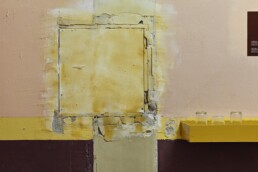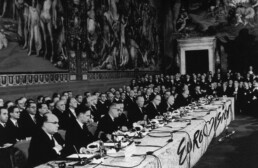DUBRAVKA SEKULIĆ (1980)
Old Gal
installation, sound
variable dimensions
2012
Magic in the Air (Eurovision, Television, Europe)
video (DVD)
8’3”
2010
Old Gal
installation, sound
variable dimensions
2012
1) Take a glass
2) Find the place where the sound is best
3) put the edge of the glass against the wall
4) bring the ear to the bottom of the glass and listen
The instructions that accompany the presentation of the work, produced for and exhibited at the 53rd October Salon, made it possible to hear the audio recording of the story Old Gal, related to the history of the former Geozavod Building in Belgrade, where the exhibition was held.
A Part of the Story
Once upon a time there was a house. The house everyone called “the most beautiful house in the town”. The most beautiful house that nobody saw from the inside, at least not intentionally. So, how can anyone say that it is the most beautiful house if they haven’t walked its corridors or at least climb its stairs, seen its interior, I ask you. Don’t they know that the beauty of a house comes from the inside? When one approaches me, one is confronted with broken windows, and starts wondering… is this really the most beautiful house in the town? How can this be… it is difficult to understand what I am. One might say that I have something like an identity crisis. It’s been a while since things actually made sense… See, I was created for a completely different time and position in society…
(…) But let me tell you my story from the beginning… This neighbourhood was of utmost importance when I was erected. I stood tall and shone, I was the promise of a future prosperous society that was being built across the river from the great empire. I was sending a message – what you across the street can do, I can do also. I was built to perform an important function in that society to be the centre of its future finances, right there, on the border. What an illusion of grandeur, what a decoration it was… but I will tell you about this later. I was always proud, at least in the first decades of my life, of the fact that I was built as an act of generosity, as a gift of a wealthy person with a vision to society. I felt special. Of the few that were created in the same manner, I was the most beautiful and luxurious. But – and here I risk sounding like my good old pal Wooster – what was more important than decoration was the sense of importance. I was built to be the centre of economy and future finances. The heart of an important capitalist country. In an affluent neighbourhood. One look from across the street, from the Bristol Hotel, would make my body shiver with anticipation of the good life that was to come. Well, that was a mistake. In my, hm, hm, years, one thing I was repeatedly convinced of was that plans usually are made for one direction, and reality goes the other way. Nothing expresses that better than the current broken windows (…)
Dubravka Sekulić
© Cultural Centre of Belgrade, October Salon Collection and the artist
Gift Contract: III-5-246/28.8.2014.
Inventory No. 1342
Photo: Cultural Centre of Belgrade’s archive, Ana Kostić
Selected Bibliography:
53rd October Salon, Good Life: Physical Narratives and Spatial Imaginations. Cultural Centre of Belgrade, 2012
Magic in the Air (Eurovision, Television, Europe)
video (DVD)
8’3”
2010
An ironic video collage of pop culture images, a story of post-World War II development of Europe from two unexpected perspectives. One follows the story of the Eurovision Best Song Contest and the other, the standardization of television, questioning their status as “neutral” phenomena. Is Europe based on a control system and are its technological standards neutral?
1956 Launching of the Eurovision Song Contest
1957 Signing of the Treaty of Rome
1961 Yugoslavia joins the Eurovision Song Contest
1968 First Eurovision in colour broadcast from London in PAL encoding system
1973 Israel joins Eurovision
1980 Morocco participates in Eurovision for the first and last time
1989 Yugoslavia, the only communist country in the contest, wins Eurovision
1990 The song Insieme, unite, unite, Europe wins at Eurovision in Zagreb
1991 Disintegration of Yugoslavia
1992 Signing of the Maastricht Treaty
1993 Upon entry into force of the Maastricht Treaty, the European Union was created
1994 Seven countries of the former Eastern Bloc, headed by Russia, join Eurovision
1994 The countries of the former Eastern Bloc begin to adapt their TV encoding system, transitioning from SECAM to PAL
2000 Turkey wins Eurovision and local politicians exclaim that Turkey is now closer to the European Union
2005 The European Broadcasting Area expands to Caucasus countries
2006 Armenia joins Eurovision
2000 Georgia joins Eurovision
2007 First digital broadcast of Eurovision from Helsinki
2008 Azerbaijan joins Eurovision
What are the rules for defining Europe?
And what is European?
Are technical standards neutral?
How do they influence physical and symbolic space?
What is the connection between the development of Europe, TV broadcast and Eurovision?
© Cultural Centre of Belgrade, October Salon Collection and the artist
Purchase Contract: III-5-518/24.12.2014.
Inventory No. 1393
Photo: still from the video work
ABOUT THE AUTHOR:
Dubravka Sekulić (1980, Niš, Serbia) is an architect-researcher. She graduated from the Faculty of Architecture, University of Belgrade, and the Design Department of the Jan van Eyck Academy in Maastricht. From 2003, she worked at the Faculty of Architecture, Belgrade University, with Professor Ivan Kucina, as a teaching assistant for various programmes, mainly dealing with cooperation with other schools. Since 2007, she has been the executive editor of the Anchor School Magazine. She collaborated with the Zagreb group Platform 9.81 and, during 2004 and 2005, was part of the group that ran the BIGZ alternative space in Belgrade. Since 2016, she has been an assistant at the Institute of Contemporary Art in Graz.

